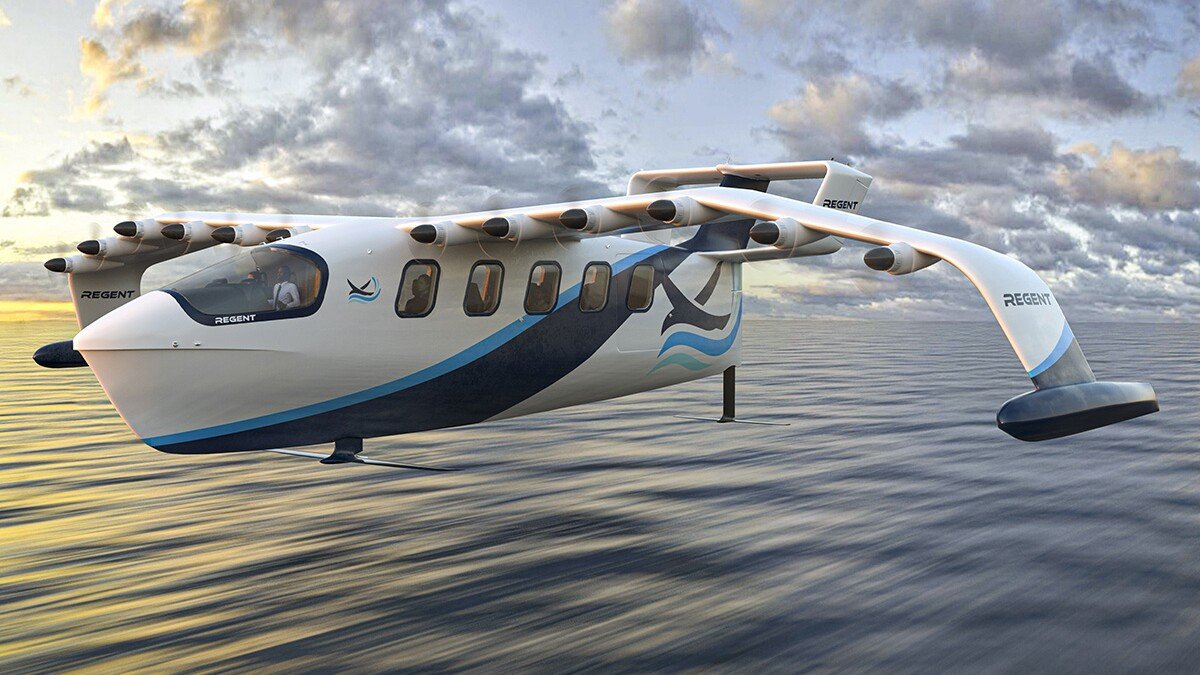Ekranoplan and Wing-in-Ground (WIG) craft have always occupied a category of their own. Unique, often controversial, and historically criticized for offering “all the limitations of a ship and none of the advantages of a plane,” these unusual vehicles never fully broke into mainstream use.
But electric aviation technology may finally change that narrative. Enter the REGENT Viceroy Seaglider — an all-electric WIG-effect vessel that promises to combine the stability of a sea vessel with the speed and efficiency of aviation.
.
What Is the Seaglider?
The Viceroy Seaglider is a 12-passenger craft designed for flights up to 180 miles (290 km) at 180 mph, operating just above coastal waters. It combines elements of a plane, hydrofoil, and boat.
Its retractable hydrofoils are used during the take-off run, after which it flies in ground effect — riding a cushion of aerodynamic efficiency a wingspan above the water’s surface. Interestingly, it’s not classified as an aircraft, which greatly simplifies certification.
A Milestone Moment: Float to Foil
On June 24, 2025, REGENT’s Seaglider achieved a key milestone — transitioning from floating on the water to riding on hydrofoils. The company’s motto, Float, Foil, Fly, reflects its step-by-step development approach. With “Float” and “Foil” now accomplished, the next stage is true ground-effect flight.
The Aerodynamics Behind WIG Craft
WIG craft exploit the ground effect, a phenomenon where flying close to a surface increases lift and reduces drag. By staying within one wingspan of the water, wings can generate 30%–80% more lift and cut induced drag by 50% or more.
The Soviets famously developed Ekranoplans during the Cold War for speed and efficiency over the sea. In recent years, interest has re-emerged, particularly in Asia, though typically with conventional propulsion. REGENT’s twist is to pair the concept with electric propulsion.
From NASA’s Vision to REGENT’s Reality
The seeds of the Seaglider’s design were planted a decade ago through NASA’s LEAPTech program (Leading Edge Asynchronous Propeller Technology). LEAPTech tested a carbon-composite wing powered by 18 small electric motors, showing that distributed electric propulsion could slash the energy required for flight by up to five times.
While NASA’s planned X-57 Maxwell demonstrator was cancelled in 2023, REGENT carried the idea forward. The Seaglider uses 12 small, nine-bladed propellers along its wing, achieving high efficiency and zero emissions.
Why the Seaglider Stands Out
Several features make the Seaglider unique:
- Hydrofoil Take-Off – The first WIG craft to combine retractable hydrofoils for smooth, efficient take-off.
- Box Tail Design – Improves control when flying 20–30 ft above the water, where reduced downwash can destabilize conventional tails.
- Digital Flight Controls – Distributed control surfaces counteract aerodynamic challenges in ground effect.
Thanks to these innovations, the Seaglider can outperform many battery-powered aircraft in speed and range.
The Road Ahead
REGENT plans to move into ground-effect flight testing, coastal route simulations, and full-scale production by 2026. With $9 billion in pre-orders from customers worldwide, the company is positioning itself to transform short-range maritime mobility.
Skimming Into the Future
From NASA’s experimental electric wings to REGENT’s sleek hydrofoil WIG craft, the path of innovation has come full circle — beginning in the skies, and now skimming the seas. By embracing the advantages of water operations — easier certification, better lift, and inherent safety — the Seaglider could redefine clean coastal transportation.
A new era has begun. And this time, the Ekranoplan might just stick around.
